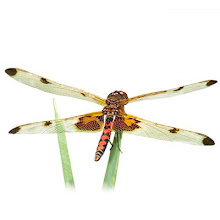Mydas Fly (Mydas sp.)
July 18, 2008
Highlight of the day was finding a group of 3 Mydas flies (guessing from size, 2 females and 1 male). The 2 females were seen laying eggs in a mulch pile along the edge of the trail. Later, one of the adults was observed feeding at Rattlesnake Master (Apiaceae Eryngium yuccifolium) flowers.
Barton County
July 11 - 13, 2008
Went to Prairie State Park hoping for good shots of Regal Fritillaries (Speyeria idalia) but came home without them. We did see a few male Regals flying back and forth over the prairie searching for females, but by this time of year, most of the females were no longer interested in the remaining males. One chase, however, was very interesting, since the male basically flew circles, similar to the path of a ferris wheel, around the female as she flew about 30' high. Several passing males were so close I almost could have reached out to touch them, and just before we reached our car when we were leaving the park, a final male passed close enough to brush its wings against the side of my head as I heard the sound made by the wings! Really frustrating not to be able to get a photo, but it's almost impossible to get a really great image of a butterfly in flight.
We did manage to find a few cool moths, the highlights were a Coffee-loving Pyrausta Moth (Crambidae Pyrausta tyralis) and a Black-bordered Lemon Moth (Noctuidae Thioptera nigrofimbria).
The highlight of the trip, though, were the fireflies. The most awesome firefly show I've seen since we went to Great Smoky Mountains National Park for the synchronized fireflies at Elkmont. We were in the campground, which is wooded, not prairie. When it started getting dark, just looking forward, there were about 50 flashes visible at any given moment. And it was the same in all directions! We were also seeing different species of fireflies in the group – the flashes were different. During the day, we were able to find resting fireflies in two different genera – Photinus and Photuris. Photinus spp. have defensive chemicals that provide protection from predators. Photuris spp. aren't chemically protected, so the females flash the pattern of Photinus females to bring males into striking range. The female then eat the male, acquiring the chemical defense of the other species. The Photuris female flashes the pattern for her own species, mates with an appropriate male, and provides the chemical protection from the Photinus firefly male to her own eggs.
Sunday, July 20, 2008
Thursday, July 10, 2008
Scissor-grinder Cicadas (Tibicen auletes)
July 7, 2008
This evening I was in the backyard and realized I was hearing cicadas. I grabbed my iPod and played the cicada section from the Singing Insects CD produced by the Missouri Department of Conservation and identified them as Scissor-grinder Cicadas. I recognized the sound as what I hear every year, but this was the first time I tried to identify the species by the sound.
July 7, 2008
This evening I was in the backyard and realized I was hearing cicadas. I grabbed my iPod and played the cicada section from the Singing Insects CD produced by the Missouri Department of Conservation and identified them as Scissor-grinder Cicadas. I recognized the sound as what I hear every year, but this was the first time I tried to identify the species by the sound.
Subscribe to:
Posts (Atom)








